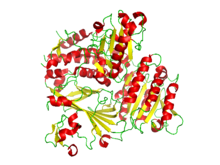- COPII
-
For the 1996 United Nations Climate Change Conference in Geneva, Switzerland, see COP 2 (climate conference).
Sec23 homolog A 
Ribbon diagram of the crystallographic structure of the COPII heterodimer of Sec23 and Sec24. Alpha helices are in red and the beta sheets are in yellow.[1] Identifiers Symbol SEC23A Entrez 856311 HUGO 10701 OMIM 610511 PDB 1M2V RefSeq NM_006364 UniProt Q15436 Other data Locus Chr. 14 q21.1 SEC24 family, member A Identifiers Symbol SEC24A Entrez 10802 HUGO 10703 OMIM 607183 PDB 1M2V RefSeq XM_001132082 UniProt O95486 Other data Locus Chr. 5 q31.1 COPII is a type of vesicle coat protein that transports proteins from the rough endoplasmic reticulum to the Golgi apparatus.[2][3] This is termed anterograde transport. The name "COPII" refers to the specific coat protein complex that initiates the budding process. The coat consists of large protein subcomplexes that are made of four different protein subunits.
Contents
Coat proteins
There are two protein heterodimers that form the coat complex. These proteins are
- Sec23p/Sec24p Heterodimer
- Sec13p/Sec31p Heterotetramer
These proteins alone are not able to cause the budding of the vesicle or direct the vesicle to the correct target membrane. SNARE, cargo, and other proteins are also needed for these processes to occur. The CopII protein does however cause the binding that forms vesicle coat, and thereby causes the release from the ER. The exact process of how the vesicle is brought to a particular location, or how that location is determined is not yet known.
Budding process
The GTPase Sar1p is a protein that hydrolyzes GTP and acts like a molecular "switch" that flips between an activated and membrane embedded GTP-bound form, and inactive and soluble GDP-bound form. Inactive GDP-bound Sar1p is attracted to the cytosolic side of the endoplasmic reticulum (ER) membrane by Sec12p. Sec12p is a guanine nucleotide exchange factor, or GEF, and a transmembrane protein residing in the ER membrane. This binding event causes Sar1p to release GDP, and since the concentration of GTP is much higher than GDP in the cytosol, GTP spontaneously binds to Sar1p. Now in a GTP bound state, Sar1p undergoes a conformational change which exposes a hydrophobic tail that can be inserted into the lipid bilayer, binding it to the membrane. Once Sar1p is bound to the membrane the coat protein complexes Sec23p/24p and Sec13p/31p bind to the membrane sequentially. These proteins simultaneously contact Sar1p and cargo proteins destined for the cis-golgi membrane. The Sec23p/24p-Sec13p/31p-Sar1p complexes then coalesce to form a much larger complex. This network deforms the membrane enough to bud a vesicle off.
At some currently unknown point the GTPase Sar1p hydrolyzes its bound GTP into GDP. This process is required before the vesicle can bud off from the membrane.
Conformational changes
CopII has three specific binding sites that can each be complexed. The picture on the right (Sed5) uses the Sec22 t-SNARE complex to bind. This site is more strongly bound, and therefore is more favored. (Embo)
Crystal structures of CopII See also
References
- ^ PDB 3EH1; Mancias JD, Goldberg J (November 2008). "Structural basis of cargo membrane protein discrimination by the human COPII coat machinery". EMBO J. 27 (21): 2918–28. doi:10.1038/emboj.2008.208. PMC 2580787. PMID 18843296. http://www.pubmedcentral.nih.gov/articlerender.fcgi?tool=pmcentrez&artid=2580787.
- ^ Lee MC, Miller EA (August 2007). "Molecular mechanisms of COPII vesicle formation". Semin. Cell Dev. Biol. 18 (4): 424–34. doi:10.1016/j.semcdb.2007.06.007. PMID 17686639.
- ^ Hughes H, Stephens DJ (February 2008). "Assembly, organization, and function of the COPII coat". Histochem. Cell Biol. 129 (2): 129–51. doi:10.1007/s00418-007-0363-x. PMC 2228377. PMID 18060556. http://www.pubmedcentral.nih.gov/articlerender.fcgi?tool=pmcentrez&artid=2228377.
- ^ a b 1PCX; 1PD0; Mossessova E, Bickford LC, Goldberg J (August 2003). "SNARE selectivity of the COPII coat". Cell 114 (4): 483–95. doi:10.1016/S0092-8674(03)00608-1. PMID 12941276.
Synaptic vesicle OtherCOPI COPII RME/Clathrin Caveolae Other/ungrouped Vesicle formationAdaptor protein complex 1: AP1AR · AP1B1 · AP1G1 · AP1G2 · AP1M1 · AP1M2 · AP1S1 · AP1S2 · AP1S3
Adaptor protein complex 2: AP2A1 · AP2A2 · AP2B1 · AP2M1 · AP2S1
Adaptor protein complex 3: AP3B1 · AP3B2 · AP3D1 · AP3M1 · AP3M2 · AP3S1 · AP3S2
Adaptor protein complex 4: AP4B1 · AP4E1 · AP4M1 · AP4S1
Coats: Retromer · TIP47Othersee also vesicular transport protein disorders
B memb: cead, trns (1A, 1C, 1F, 2A, 3A1, 3A2-3, 3D), othrCategories:- Genes on chromosome 14
- Genes on chromosome 5
- Cell biology
Wikimedia Foundation. 2010.


